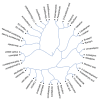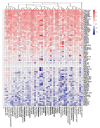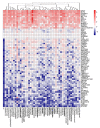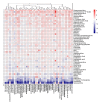Active Components of Commonly Prescribed Medicines Affect Influenza A Virus-Host Cell Interaction: A Pilot Study
- PMID: 34452402
- PMCID: PMC8402715
- DOI: 10.3390/v13081537
Active Components of Commonly Prescribed Medicines Affect Influenza A Virus-Host Cell Interaction: A Pilot Study
Abstract
Background: Every year, millions of people are hospitalized and thousands die from influenza A virus (FLUAV) infection. Most cases of hospitalizations and death occur among the elderly. Many of these elderly patients are reliant on medical treatment of underlying chronic diseases, such as arthritis, diabetes, and hypertension. We hypothesized that the commonly prescribed medicines for treatment of underlying chronic diseases can affect host responses to FLUAV infection and thus contribute to the morbidity and mortality associated with influenza. Therefore, the aim of this study was to examine whether commonly prescribed medicines could affect host responses to virus infection in vitro. Methods: We first identified 45 active compounds from a list of commonly prescribed medicines. Then, we constructed a drug-target interaction network and identified the potential implication of these interactions for FLUAV-host cell interplay. Finally, we tested the effect of 45 drugs on the viability, transcription, and metabolism of mock- and FLUAV-infected human retinal pigment epithelial (RPE) cells. Results: In silico drug-target interaction analysis revealed that drugs such as atorvastatin, candesartan, and hydroxocobalamin could target and modulate FLUAV-host cell interaction. In vitro experiments showed that at non-cytotoxic concentrations, these compounds affected the transcription and metabolism of FLUAV- and mock-infected cells. Conclusion: Many commonly prescribed drugs were found to modulate FLUAV-host cell interactions in silico and in vitro and could therefore affect their interplay in vivo, thus contributing to the morbidity and mortality of patients with influenza virus infections.
Keywords: commonly prescribed drugs; drug adverse reaction; influenza virus; virus–host interaction.
Conflict of interest statement
The authors declare no conflict of interest.
Figures








Similar articles
-
Unexpected Functional Divergence of Bat Influenza Virus NS1 Proteins.J Virol. 2018 Feb 12;92(5):e02097-17. doi: 10.1128/JVI.02097-17. Print 2018 Mar 1. J Virol. 2018. PMID: 29237829 Free PMC article.
-
Tetherin Sensitivity of Influenza A Viruses Is Strain Specific: Role of Hemagglutinin and Neuraminidase.J Virol. 2015 Sep;89(18):9178-88. doi: 10.1128/JVI.00615-15. Epub 2015 Jun 24. J Virol. 2015. PMID: 26109730 Free PMC article.
-
Different neuraminidase inhibitor susceptibilities of human H1N1, H1N2, and H3N2 influenza A viruses isolated in Germany from 2001 to 2005/2006.Antiviral Res. 2009 Apr;82(1):34-41. doi: 10.1016/j.antiviral.2009.01.006. Epub 2009 Feb 6. Antiviral Res. 2009. PMID: 19428593
-
Non-hydrolyzed in digestive tract and blood natural L-carnosine peptide ("bioactivated Jewish penicillin") as a panacea of tomorrow for various flu ailments: signaling activity attenuating nitric oxide (NO) production, cytostasis, and NO-dependent inhibition of influenza virus replication in macrophages in the human body infected with the virulent swine influenza A (H1N1) virus.J Basic Clin Physiol Pharmacol. 2013;24(1):1-26. doi: 10.1515/jbcpp-2012-0037. J Basic Clin Physiol Pharmacol. 2013. PMID: 23425625 Review.
-
Host microRNAs and exosomes that modulate influenza virus infection.Virus Res. 2020 Apr 2;279:197885. doi: 10.1016/j.virusres.2020.197885. Epub 2020 Jan 22. Virus Res. 2020. PMID: 31981772 Review.
Cited by
-
A Dual Pharmacological Strategy against COVID-19: The Therapeutic Potential of Metformin and Atorvastatin.Microorganisms. 2024 Feb 13;12(2):383. doi: 10.3390/microorganisms12020383. Microorganisms. 2024. PMID: 38399787 Free PMC article. Review.
-
Tyrosine Kinase Inhibitors Target B Lymphocytes.Biomolecules. 2023 Feb 25;13(3):438. doi: 10.3390/biom13030438. Biomolecules. 2023. PMID: 36979373 Free PMC article.
-
Broad-Spectrum Antivirals and Antiviral Combinations: An Editorial Update.Viruses. 2022 Oct 14;14(10):2252. doi: 10.3390/v14102252. Viruses. 2022. PMID: 36298807 Free PMC article.
-
Broad-Spectrum Antivirals and Antiviral Drug Combinations.Viruses. 2022 Feb 1;14(2):301. doi: 10.3390/v14020301. Viruses. 2022. PMID: 35215894 Free PMC article.
References
-
- Gupta A., Madhavan M.V., Poterucha T.J., DeFilippis E.M., Hennessey J.A., Redfors B., Eckhardt C., Bikdeli B., Platt J., Nalbandian A., et al. Association between antecedent statin use and decreased mortality in hospitalized patients with COVID-19. Nat. Commun. 2021;12:1325. doi: 10.1038/s41467-021-21553-1. - DOI - PMC - PubMed
-
- Anastasina M., Le May N., Bugai A., Fu Y., Soderholm S., Gaelings L., Ohman T., Tynell J., Kyttanen S., Barboric M., et al. Influenza virus NS1 protein binds cellular DNA to block transcription of antiviral genes. Biochim. Biophys. Acta. 2016;1859:1440–1448. doi: 10.1016/j.bbagrm.2016.09.005. - DOI - PubMed
Publication types
MeSH terms
Substances
LinkOut - more resources
Full Text Sources
Other Literature Sources
Medical

